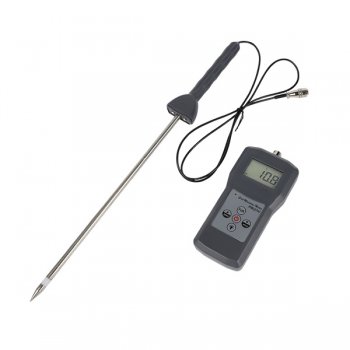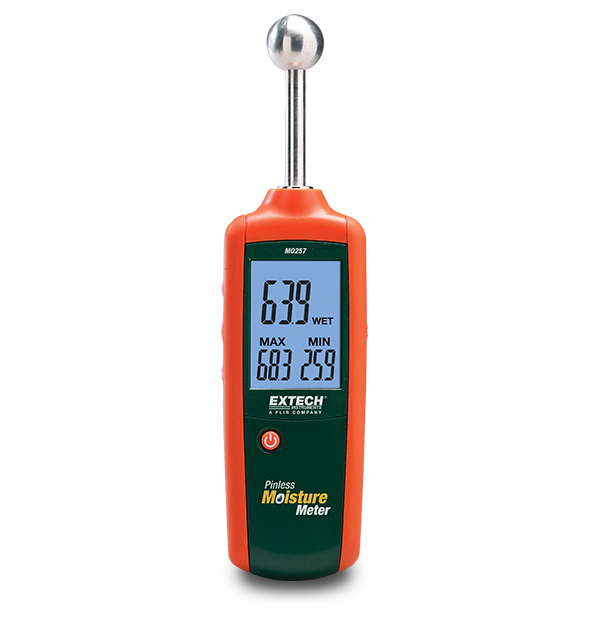Recognizing the Various Sorts Of Moisture Meters and Their Applications
Wiki Article
Look Into the Globe of Moisture Meters: Whatever You Need to Know
In the realm of moisture meters exists a world of precision and usefulness that frequently goes unnoticed. Understanding exactly how moisture meters operate, the various types offered, and their varied usages can drop light on their significance in making sure top quality and efficiency.Just How Moisture Meters Job
Moisture meters run by determining the electric conductivity or capacitance of materials to determine the wetness content existing - Moisture Meter. These meters are indispensable tools throughout various sectors, including building, farming, and woodworking. By utilizing various approaches such as pin-type or pinless technology, dampness meters give exact readings that assist specialists make notified decisionsPin-type dampness meters work by putting the sharp pins into the product being examined. On the other hand, pinless moisture meters utilize electro-magnetic signals to scan a larger area without triggering any type of damages to the product's surface.
No matter the approach used, wetness meters play a critical function in protecting against issues such as mold and mildew development, structural damages, or item defects triggered by excess dampness. Comprehending exactly how these meters job is vital for making certain the quality and stability of products in various applications.
Types of Wetness Meters
Offered the critical duty moisture meters play in numerous industries, it is important to understand the various types available to professionals for accurately assessing dampness degrees. There are largely two main sorts of moisture meters: pinless and pin-type wetness meters.
Pin-type moisture meters use 2 pins that are put into the material being examined to measure the electrical resistance in between them. This approach is typically used for timber, drywall, and other building products. Pin-type meters provide accurate readings at particular midsts, making them optimal for identifying dampness gradients.
On the other hand, pinless moisture meters use electromagnetic sensing unit plates to check a larger location of the product without creating any kind of damage. This kind appropriates for rapidly scanning large areas and is frequently made use of for floor covering, wall surfaces, and ceilings. Pinless meters are convenient for taking analyses on completed surfaces without leaving any noticeable marks.
Both kinds of moisture meters have their advantages and are selected based upon the specific demands of the work at hand. Understanding the differences in between these kinds is important for specialists to make exact moisture evaluations.
Applications Across Industries
With varied capabilities, moisture meters find extensive application throughout numerous industries, helping specialists in guaranteeing ideal problems for products and frameworks. In the farming sector, wetness meters are invaluable for identifying the wetness web content in grains, seeds, and hay, making certain quality assurance and avoiding mold and mildew development. Building experts rely upon wetness meters to assess the wetness degrees in helpful site structure materials like concrete, timber, and drywall, which is essential for maintaining architectural stability and preventing problems like rot or mold and mildew. The floor covering sector utilizes wetness meters to gauge the moisture material in subfloors prior to installing various floor coverings, stopping expensive damages due to excess moisture. In the food industry, wetness meters are utilized to check and manage moisture levels in items such as grains, nuts, and dried fruits to keep freshness and quality. Furthermore, moisture meters play a crucial function in the remediation and damage control market by aiding specialists recognize and attend to water damage in structures quickly. Throughout these diverse sectors, moisture meters are vital tools for making sure the quality, security, and durability of numerous materials and items.Tips for Using Dampness Meters
Utilize the moisture meter's calibration setups to make certain exact analyses when determining the moisture content in various products. In addition, make certain the meter is set to the correct moisture array for the product you are determining to acquire the most accurate results.
When using a pin-type moisture meter, insert the pins to the suitable depth suggested for the product being examined. This ensures that the moisture readings are taken from the correct depth within the material, offering a much more precise representation of its dampness material. For pinless moisture meters, remember to keep proper call with the material's surface to obtain trusted analyses.

Routinely examine and change the batteries in your wetness meter to stop inaccurate analyses due to low power. When not in usage to extend its life expectancy and keep its this page precision, Shop the meter in a risk-free and dry area. By following these pointers, you can maximize the efficiency of your dampness meter and obtain exact moisture material dimensions across different products.

Upkeep and Calibration
To make sure the accuracy of dampness content dimensions, regular upkeep and calibration of the moisture meter are essential actions in its proper performance. Maintenance includes keeping the wetness meter tidy and complimentary from debris that might affect its readings. It is very important to comply with the manufacturer's guidelines for cleansing to avoid damages to the gadget. In addition, routine calibration is essential to confirm the precision of the readings. Calibration readjusts the moisture meter to make sure that it provides dependable and regular results.Calibration must be done occasionally, specifically if the moisture meter is utilized frequently or in crucial applications where precise dimensions are required. By adjusting the dampness and maintaining meter on a regular basis, customers can rely on the precision of the dampness material measurements gotten.
Conclusion
Finally, dampness meters play an important duty in numerous sectors by properly measuring the wetness material of materials. Understanding exactly how these devices work, the different types offered, and correct upkeep and calibration are necessary for acquiring reliable outcomes. Whether in farming, manufacturing, or construction, using moisture meters aids ensure top quality control and effectiveness in processes.Building specialists depend on moisture meters to examine the dampness degrees in structure products like concrete, timber, and drywall, which is crucial for maintaining structural stability and stopping issues like rot or click reference mold and mildew. The flooring market utilizes wetness meters to gauge the moisture material in subfloors prior to mounting numerous floor coverings, stopping pricey problems due to excess moisture.Utilize the wetness meter's calibration setups to make certain exact readings when measuring the moisture material in different products. By adhering to these pointers, you can make best use of the efficiency of your moisture meter and obtain accurate wetness material measurements across various products.
In verdict, dampness meters play an important function in different sectors by properly gauging the dampness web content of products.
Report this wiki page